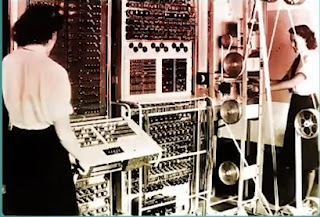Embedded System, the name itself says us that something is embedded into a system and the reason behind this the usage of an Embedded System as a combination of Hardware and Software. We will not even spend a single day without an embedded system (is it true?). Every electronic gadget from our Cell phone to Washing machines is an Embedded System. This gives the situation os embedded systems in contemporary scenario. These are specific and perform the tasks assigned.
Let's have at how Embedded Systems were evolved and reasons behind them and advancements with help of tech giants from that day to this day:
It is all due to development of semiconductor technology without which there are no embedded systems because every part of the embedded system is a semiconductor.
 1944 The first Electronic machine was invented for the battle purpose Colossus Mark-I and Mark-II
1944 The first Electronic machine was invented for the battle purpose Colossus Mark-I and Mark-IISo we could just say we humans make new inventions and new technologies only when we are in crisis or in a huge problem that could be solved only if we have a new instrument that was not there up to that time.
This computer is used to decode and read German messages by British during the World War-II.
That is the period during which the usage of computer and transformation in electronics started.
1960 Then a most crucial NASA's Lunar machine program called Apollo Guidance Computer was made and developed by MIT professor Charle Stark Draper who is the head of the project. This computer is the first one to be used to observe the motion os satellite and send commands and receive information from the satellite. This undertook many transformations but initially, it is the first Embedded System ever made and it operates at a 1MHz clock and 4kb words ROM and 256 words of RAM. It is even equipped with a user interface which has a 7 segment display and keyboard which allows scientists to input data manually a made their tasks much easier and reduced the complexity of interaction with the software in the embedded system. So we can say this is the first recognized Embedded System.

1961 another important invention was made for the military purpose it is called The Minuteman-I missile was developed for defense purposes and for this Autonetics D-17 computer is developed and this has a discrete transistor logic and even has a hard disk for main memory and this is the first embedded system to be made in large quantity and got a great demand at that time in 1965 first embedded system based computer was launched which is a 12 bit PDP computer.
Later in 1966, The Minuteman-II missile was made with several major technical advancements this replaces with new Autonetics computer in larger numbers which made cost from $1000 each to $3 each. Due to its affordability, many applications came into existence.
 1968 INTEL was founded by Noyce and Moore and this led to the development of many lower level microprocessors which are used in various applications and they even made microcontrollers which are the combination of microprocessors and this made a clear platform to the advancement of embedded systems and many practical applications of the time. So they have become the heart of Electronics Field.
1968 INTEL was founded by Noyce and Moore and this led to the development of many lower level microprocessors which are used in various applications and they even made microcontrollers which are the combination of microprocessors and this made a clear platform to the advancement of embedded systems and many practical applications of the time. So they have become the heart of Electronics Field.
1969 The Automobile giant Volkswagen cars introduced MicroProcessor based Fuel Injection system which is a breakthrough in the world of automobiles.
Thus in a few years, the Embedded systems evolved... gained popularity.... and had become a necessity in the span of 25 years and later on it took very faster and quicker transformations and finally stood at a World Ruling Position.
I will be covering the advancements of embedded systems in 1970-2018 in the next post Don't miss that.Thanks for spending your valuable time for reading my blog.
I hope I have shared some valuable information with you.
Happy Reading
Evolution of Embedded Systems (1944-1970)
 Reviewed by Akhil Kumar
on
January 09, 2018
Rating:
Reviewed by Akhil Kumar
on
January 09, 2018
Rating:
 Reviewed by Akhil Kumar
on
January 09, 2018
Rating:
Reviewed by Akhil Kumar
on
January 09, 2018
Rating:










No comments: